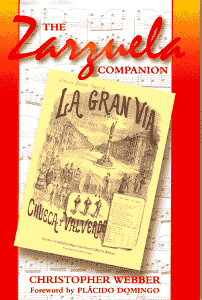For non-Spanish speakers the world of zarzuela
(Hispanic opera-operetta with spoken dialogue) is a closed one.
I came to this book as an intrigued visitor rather than a convinced
Zarzuela aficionado. My interest was piqued years ago by the Zarzuela
LPs listed in Gramex, Henry Stave and Harold Moores adverts in
Gramophone. I sometimes wonder whether a large part of the interest
of Gramophone in years gone by was the esoterica listed on those
pages.
Zarzuela can be viewed as the Iberian counterpart
to the Viennese operetta, the Gilbert and Sullivan tradition and
the Broadway musical. This book is essentially a reference guide
to the lives and principal zarzuelas of 22 Spanish composers with
separate 'mopping up' chapters for the zarzuela tradition in the
19th century and 20th century, as well as in Catalonia and Cuba.
Leading writers and singers in the genre are profiled in two separate
chapters. There is a select discography as well as a bibliography
and an extremely valuable glossary as well as a brief history
of the genre. The 12 page index makes this an even more practical
aid to the researcher and the enthusiast.
I suspect that this is the first English language
book to tackle the subject and it does so agreeably and with every
appearance of diligence. Its virtues make this a firm basis for
the extension of zarzuela beyond the Hispanic world.
The composers accorded their own chapter are
Alonso, Arrieta, Barbieri, Bretón, Chapí, Chueca,
Caballero, Gaztambide, Giménez, Guerrero, Guridi, Lleó,
Luna, Millán, Torroba, Penella, Serrano, Sorozábal,
Soutullo, Vert, Torregrosa, Usandizaga and Vives. A few of these
names (Guridi, Chapí, Breton, Usandizaga, Sorozabal, Vives,
Torroba) are likely to be familiar to the general classical music
lover but most are unknowns or they were until this book came
along. There are no portraits of the composers.
I rather missed Chris Webber telling us about
how he was drawn into this arcane world. The passionate quest
and the disappointments and discoveries are a dimension I had
hoped for. I also missed a quick and personal guide to the best
recordings by which to enter this world and perhaps a list of
retailers, web addresses and sources. Also why is the URL for
the author's outstanding website (www.nashwan.demon.co.uk)
tucked away on page xii?
There is a decorous and personable foreword by
Plácido Domingo in which he addresses the genre as well
as giving us a personal introduction to the history of his parents
as leading Zarzuela practitioners.
The dustjacket, designed by the author, is extremely
well done. Its scorched orange and flame hints at both the passionate
world of the Zarzuela and the colours of the Spanish flag.
This is the English language guide to
Zarzuela. It sits very happily next to the Grove Opera and the
New Penguin Opera Guide and need not blush in that company. Its
value is as a reliable and apparently thorough reference work.
Despite my gripe about things that are missing what is there is
the key to an enclosed garden that promises pleasures and a lifetime's
pursuit. Very happily recommended if you are at all curious about
the Zarzuela world.
Rob Barnett
